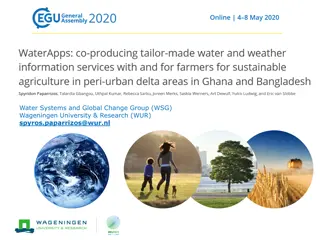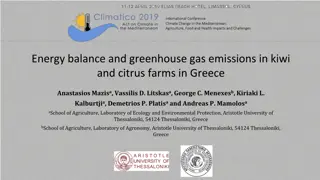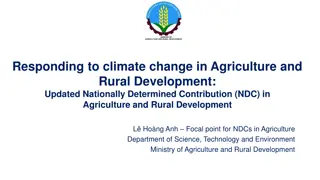Implications of Climate Change for Australian Agriculture
The implications of climate change for Australian agriculture are significant, with adjustments in total factor productivity and existing adaptive responses being crucial. Advanced technologies also play a key role in both current and potential applications for sustainable agricultural practices.
Download Presentation

Please find below an Image/Link to download the presentation.
The content on the website is provided AS IS for your information and personal use only. It may not be sold, licensed, or shared on other websites without obtaining consent from the author. Download presentation by click this link. If you encounter any issues during the download, it is possible that the publisher has removed the file from their server.
E N D
Presentation Transcript
1 The Cairns Institute The implications of climate change for Australian agriculture Distinguished Professor Stewart Lockie
Total factor productivity volatile Adjusted for climate: 28% increase in broadacre productivity since 1988-89 68% increase in cropping productivity since 1988-89 But
Adaptation to what? Adaptation of what?
Existing adaptive responses to climate variability in Australian agriculture Adaptive response Existing and Emerging Strategies Soil moisture monitoring Use of seasonal forecasts Match stocking rates to pasture condition/ destocking/ agistment Adjust timing of operations (sowing, harvest, watering etc.) Water use efficiency measures (e.g. drip irrigation) Reduced tillage, stubble retention Water and soil conservation works Selection for drought tolerance Introduction of drought tolerant varieties Diversify farm enterprise mix Change land use (e.g. cropping to forestry) Relocation to more climatically favourable regions Incremental Optimisation Substitution Conversion New industries (e.g. macroalgae aquaculture) Production of ecosystem services (biodiversity offsets, carbon credits) Transformative Incubation
Existing and potential applications of advanced technology in Australian agriculture Adaptive response Production Business Market Incremental Monitoring Sensors/IoT Traceability Block chain Seasonal forecasting/ enterprise analytics/ AI Forecasting Optimisation Precision agriculture Flexible ownership Sharing platforms Consumer targeting Consumer behavioural analytics Efficiency Automation Telecommunications Alternative markets New genetics Gene editing Personalised markets Substitution New/enhanced inputs Nanotechnology Personalised products, experiences, nutrition Conversion Enterprise change Terrestrial aquaculture New markets Novel food and fibre industries Incubation Acellular meat Transformative
Pushing the needle toward transformative adaptation Technological disruption time for a step change Action on multiple planetary and social risks Social, economic and epistemic inclusion of First Peoples Demanding buyers (and suppliers!) verifiable sustainability claims























